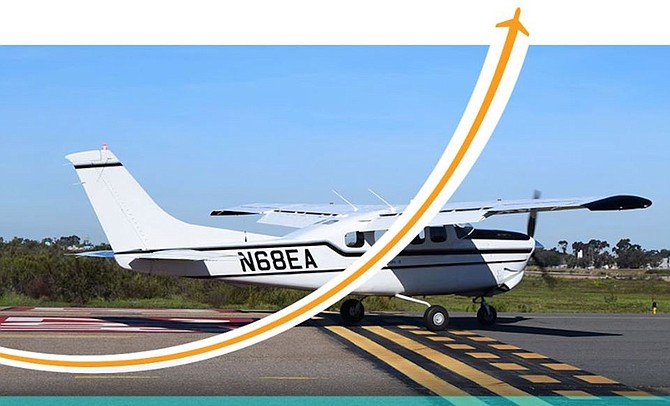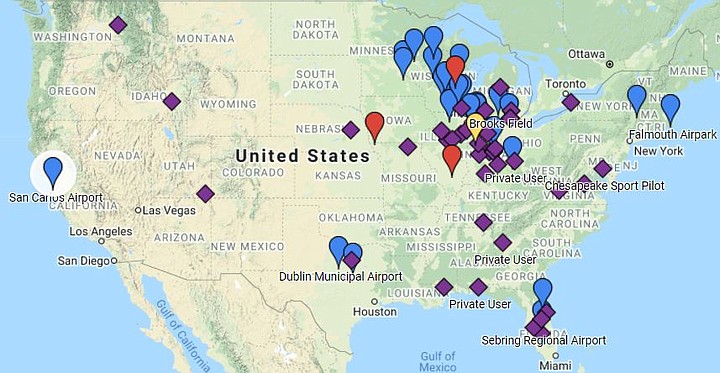 Facebook
Facebook
 X
X
 Instagram
Instagram
 TikTok
TikTok
 Youtube
Youtube

Efforts to bring unleaded fuel to Montgomery-Gibbs Executive Airport haven't gotten far, but a study of an airport less than half its size is raising new concerns about lead exposure in children.
Today {Aug. 24}, a petition was filed by Earthjustice, Santa Clara County and community groups that include Montgomery Gibbs Environmental Coalition, urging the Environmental Protection Agency to regulate lead in airplane fuel.
Even though it's been 25 years since lead was removed from gas used in autos, aviation fuel known as "avgas" still relies on it. Most airborne lead in the U.S. comes from aircraft.
The groups filed the petition after a study that reviewed 10 years of data from Santa Clara County found blood lead level increases in children downwind of Reid-Hillview Airport are similar to those seen in the Flint, Michigan water crisis.

Clairemont and Serra Mesa border the Montgomery-Gibbs airport.
"We are not aware of any studies measuring the blood lead levels of children near San Diego airports," says Kelly Lester, one of the attorneys leading the case.
But two other studies have measured blood lead levels of children around airports where leaded avgas is used, and the news was no better. Each showed that children who lived close to the airport had higher levels of lead in their blood.
Clairemont's eastern boundary is directly in the flightpath of northbound takeoffs from Montgomery-Gibbs and has twelve elementary schools, two middle schools, and two high schools, according to the Montgomery Gibbs Environmental Coalition.
Serra Mesa, which also borders the airport, has homes only a city block from the entrance to the airport. One of the six Serra Mesa elementary schools is within a half-mile of the airport, and located under the takeoff pattern of east and southbound planes, and touch and go flight school operations.
Two private schools are located even closer to the airport boundary.
Lead, a potent neurotoxin that can cause learning delays and other health problems, builds up in the body over time. Of the top 15 airports with the highest lead emissions across the county, two are in San Diego County, and dozens more with lead emissions are located in San Diego, Lester says.
A new lease approved in April for Montgomery Gibbs has no requirement to phase out avgas or introduce unleaded fuel. Officials have said such changes are 4-5 years away.
Currently, Indiana-based Swift Fuels is the only company in the U.S. selling unleaded aviation gasoline, known as UL94 avgas, which has been available since 2015.
Airport officials have raised issues about the cost to transport the fuel from the Midwest, the need for dedicated tanks for the unleaded gas and concerns about intermixing leaded and unleaded.
"Many small planes aren't FAA approved to use this fuel, which now serves up to 66 percent of the US piston fleet," says Chris D’Acosta, CEO of Swift Fuels.
"Commingling of 100LL (leaded) and UL94 unleaded avgas in the wing tank of an aircraft is 100 percent safe – as long as the aircraft and engine are approved for the use of UL94," he says.
"The pilots who use my fuel know the process for their aircraft. They follow FAA-required instructions."
D’Acosta says he is the "sole party responsible for determining the cost of UL94 fuel delivered to any airport."
Jorge Rubio, airport deputy director, says city staff have met with the local providers of retail fuel at Montgomery-Gibbs and Brown Field, as well as Swift Fuels, to consider bringing unleaded aviation fuel to municipal airports.
"The local fuel providers have not provided an estimated timeline on procuring UL94," but staff is considering ways "to encourage the local use of unleaded aviation fuels as they continue to be developed."
Cost and availability have presented challenges, he says, "but as time goes by, those are hurdles the providers and manufacturers are overcoming. Locally, additional fuel storage tanks would also need to be planned out and built."
Unfortunately, there are no clear answers to how long the petition will take if it succeeds, Lester says. Before EPA makes an endangerment finding, they will give notice to the public and accept comments on the agency's action.
Once they have made the endangerment finding, it will go through a new rulemaking process for the emissions standards, along with more public input before finalizing any standards. There are no explicit deadlines, but the law requires a "reasonable" time frame, she says.
"It will likely be a few years before there are changes at the airports."


Efforts to bring unleaded fuel to Montgomery-Gibbs Executive Airport haven't gotten far, but a study of an airport less than half its size is raising new concerns about lead exposure in children.
Today {Aug. 24}, a petition was filed by Earthjustice, Santa Clara County and community groups that include Montgomery Gibbs Environmental Coalition, urging the Environmental Protection Agency to regulate lead in airplane fuel.
Even though it's been 25 years since lead was removed from gas used in autos, aviation fuel known as "avgas" still relies on it. Most airborne lead in the U.S. comes from aircraft.
The groups filed the petition after a study that reviewed 10 years of data from Santa Clara County found blood lead level increases in children downwind of Reid-Hillview Airport are similar to those seen in the Flint, Michigan water crisis.

Clairemont and Serra Mesa border the Montgomery-Gibbs airport.
"We are not aware of any studies measuring the blood lead levels of children near San Diego airports," says Kelly Lester, one of the attorneys leading the case.
But two other studies have measured blood lead levels of children around airports where leaded avgas is used, and the news was no better. Each showed that children who lived close to the airport had higher levels of lead in their blood.
Clairemont's eastern boundary is directly in the flightpath of northbound takeoffs from Montgomery-Gibbs and has twelve elementary schools, two middle schools, and two high schools, according to the Montgomery Gibbs Environmental Coalition.
Serra Mesa, which also borders the airport, has homes only a city block from the entrance to the airport. One of the six Serra Mesa elementary schools is within a half-mile of the airport, and located under the takeoff pattern of east and southbound planes, and touch and go flight school operations.
Two private schools are located even closer to the airport boundary.
Lead, a potent neurotoxin that can cause learning delays and other health problems, builds up in the body over time. Of the top 15 airports with the highest lead emissions across the county, two are in San Diego County, and dozens more with lead emissions are located in San Diego, Lester says.
A new lease approved in April for Montgomery Gibbs has no requirement to phase out avgas or introduce unleaded fuel. Officials have said such changes are 4-5 years away.
Currently, Indiana-based Swift Fuels is the only company in the U.S. selling unleaded aviation gasoline, known as UL94 avgas, which has been available since 2015.
Airport officials have raised issues about the cost to transport the fuel from the Midwest, the need for dedicated tanks for the unleaded gas and concerns about intermixing leaded and unleaded.
"Many small planes aren't FAA approved to use this fuel, which now serves up to 66 percent of the US piston fleet," says Chris D’Acosta, CEO of Swift Fuels.
"Commingling of 100LL (leaded) and UL94 unleaded avgas in the wing tank of an aircraft is 100 percent safe – as long as the aircraft and engine are approved for the use of UL94," he says.
"The pilots who use my fuel know the process for their aircraft. They follow FAA-required instructions."
D’Acosta says he is the "sole party responsible for determining the cost of UL94 fuel delivered to any airport."
Jorge Rubio, airport deputy director, says city staff have met with the local providers of retail fuel at Montgomery-Gibbs and Brown Field, as well as Swift Fuels, to consider bringing unleaded aviation fuel to municipal airports.
"The local fuel providers have not provided an estimated timeline on procuring UL94," but staff is considering ways "to encourage the local use of unleaded aviation fuels as they continue to be developed."
Cost and availability have presented challenges, he says, "but as time goes by, those are hurdles the providers and manufacturers are overcoming. Locally, additional fuel storage tanks would also need to be planned out and built."
Unfortunately, there are no clear answers to how long the petition will take if it succeeds, Lester says. Before EPA makes an endangerment finding, they will give notice to the public and accept comments on the agency's action.
Once they have made the endangerment finding, it will go through a new rulemaking process for the emissions standards, along with more public input before finalizing any standards. There are no explicit deadlines, but the law requires a "reasonable" time frame, she says.
"It will likely be a few years before there are changes at the airports."
Comments